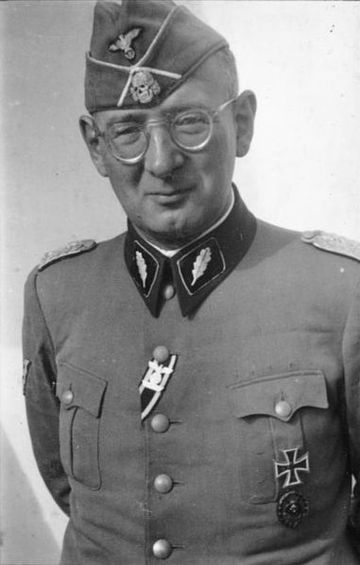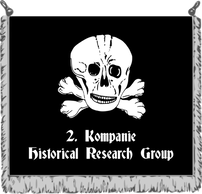awards
|
promotions
|
Early life and career

Simon was born in Breslau. In 1917 he joined the Royal Prussian Army's Leib-Kürassier-Regiment Großer Kurfürst, which was part of the 11th Division. He served in Macedonia and on the Western Front, being awarded the Iron Cross 2nd class.
At the end of the war he joined the Freikorps in Silesia and fought against the Polish forces. His unit was later incorporated into the Reichswehr as the 16th Cavalry Regiment and Simon was promoted to Unterfeldwebel.
In May 1933 he joined the SS service number 83 086 and the NSDAP party number 1 350 576, and was assigned to the 7th SS-Standarte in Gera and was promoted to Untersturmführer (Second Lieutenant) in November 1934, until ordered to raise a new unit in 1935, 1st SS Totenkopfstandarte Oberbayern and given the rank of Standartenführer.
In 1934 he was appointed as the commander of the Sachsenburg, concentration camp.
In 1938 he was involved in the Anschluss of Austria, the occupation of Bohemia and Moravia and the occupation of the Sudetenland.
During the Battle of France Simon, led his regiment in the capture of Pixie, Lyon, Orléans, Tours and Bordeaux and then advanced to the border with Spain.
In July 1941 Simon was involved in the invasion of Russia, (Operation Barbarossa) as part of Army Group North, taking Kraslava and breaking through the Stalin line, where Simon was wounded. In the weeks after the invasion Simon's regiment, during the fighting south of Lake Ilmen, captured huge quantities of Russian equipment and numerous prisoners. For the fighting in the Battles of the Demyansk Pocket, Simon was awarded the Knight's Cross and promoted to Oberführer.
In December 1942 Simon was promoted again to Brigadeführer, prior to being given command of the 16th SS Panzergrenadier Division Reichsführer-SS.
This new Waffen SS division would be formed in Hungary from Simon's old regiment and the Sturmbrigade Reichsführer SS.
In July 1944 the division was moved to Italy, and fought, never complete, at Anzio and later in the Arno sector, where it gained a reputation for stability although it suffered heavy losses during the battles in the Apennines. The division also fought against partisans in the Rückraum area, perpetrating several major atrocities against the civilians,(Sant'Anna di Stazzema massacre and Marzabotto massacre) for which Simon was awarded the Oakleaves for the Knight's Cross and the German Cross in Gold, in October 1944.
In November 1944, Simon was promoted to SS-Gruppenführer (Lieutenant General) und Generalleutnant der Waffen-SS, and given command of the XII SS Corps.
The XIII SS Corps deployed to the Lorraine region against the United States Army, and from December 1944 defended the Siegfried Line, now called the western wall.
The XIII SS Army Corps was forced to withdraw into the Saarland and the Palatinate where it started to destroy the Rhine bridges.[3]
In April 1945 between Main and Jagst it came up against the 4th US Armored Division and was involved in heavy fighting around the Tauber – Colombia line and around Würzburg and Nuremberg.
The Corps then fought a withdrawal to the Danube and around Munich. On the orders of Simon the bridges over the Isar were not blown up, as he believed there was no need as the end of the war was near.
On 1 May 1945 the Corps surrendered to the American forces.
After the war, Max Simon was sentenced to death by a British court for his part in the Marzabotto massacre. This sentence was later changed to life imprisonment. Simon was pardoned in 1954 and released from prison.
Max Simon died on 1 February 1961 in Lünen.
At the end of the war he joined the Freikorps in Silesia and fought against the Polish forces. His unit was later incorporated into the Reichswehr as the 16th Cavalry Regiment and Simon was promoted to Unterfeldwebel.
In May 1933 he joined the SS service number 83 086 and the NSDAP party number 1 350 576, and was assigned to the 7th SS-Standarte in Gera and was promoted to Untersturmführer (Second Lieutenant) in November 1934, until ordered to raise a new unit in 1935, 1st SS Totenkopfstandarte Oberbayern and given the rank of Standartenführer.
In 1934 he was appointed as the commander of the Sachsenburg, concentration camp.
In 1938 he was involved in the Anschluss of Austria, the occupation of Bohemia and Moravia and the occupation of the Sudetenland.
During the Battle of France Simon, led his regiment in the capture of Pixie, Lyon, Orléans, Tours and Bordeaux and then advanced to the border with Spain.
In July 1941 Simon was involved in the invasion of Russia, (Operation Barbarossa) as part of Army Group North, taking Kraslava and breaking through the Stalin line, where Simon was wounded. In the weeks after the invasion Simon's regiment, during the fighting south of Lake Ilmen, captured huge quantities of Russian equipment and numerous prisoners. For the fighting in the Battles of the Demyansk Pocket, Simon was awarded the Knight's Cross and promoted to Oberführer.
In December 1942 Simon was promoted again to Brigadeführer, prior to being given command of the 16th SS Panzergrenadier Division Reichsführer-SS.
This new Waffen SS division would be formed in Hungary from Simon's old regiment and the Sturmbrigade Reichsführer SS.
In July 1944 the division was moved to Italy, and fought, never complete, at Anzio and later in the Arno sector, where it gained a reputation for stability although it suffered heavy losses during the battles in the Apennines. The division also fought against partisans in the Rückraum area, perpetrating several major atrocities against the civilians,(Sant'Anna di Stazzema massacre and Marzabotto massacre) for which Simon was awarded the Oakleaves for the Knight's Cross and the German Cross in Gold, in October 1944.
In November 1944, Simon was promoted to SS-Gruppenführer (Lieutenant General) und Generalleutnant der Waffen-SS, and given command of the XII SS Corps.
The XIII SS Corps deployed to the Lorraine region against the United States Army, and from December 1944 defended the Siegfried Line, now called the western wall.
The XIII SS Army Corps was forced to withdraw into the Saarland and the Palatinate where it started to destroy the Rhine bridges.[3]
In April 1945 between Main and Jagst it came up against the 4th US Armored Division and was involved in heavy fighting around the Tauber – Colombia line and around Würzburg and Nuremberg.
The Corps then fought a withdrawal to the Danube and around Munich. On the orders of Simon the bridges over the Isar were not blown up, as he believed there was no need as the end of the war was near.
On 1 May 1945 the Corps surrendered to the American forces.
After the war, Max Simon was sentenced to death by a British court for his part in the Marzabotto massacre. This sentence was later changed to life imprisonment. Simon was pardoned in 1954 and released from prison.
Max Simon died on 1 February 1961 in Lünen.
DISCLAIMER: 2. Kompanie is a non-political organization We do not support naziism, or fascism. We are not associated with nor do we condone the actions of the Third Reich or the actual 3.SS Division.
